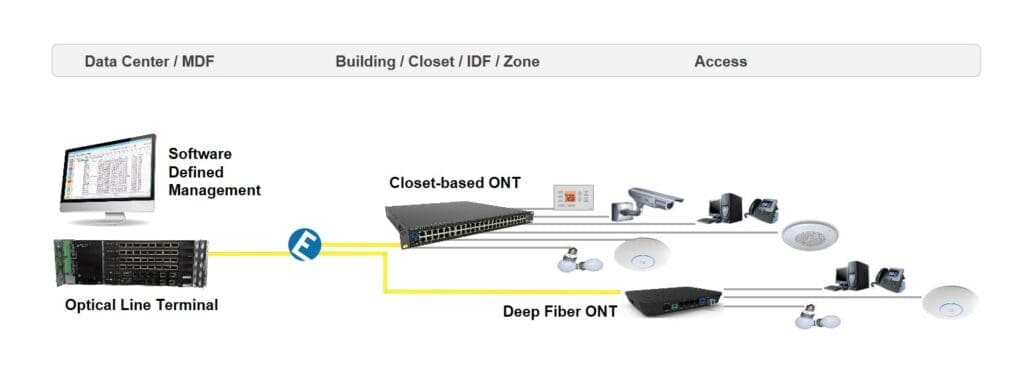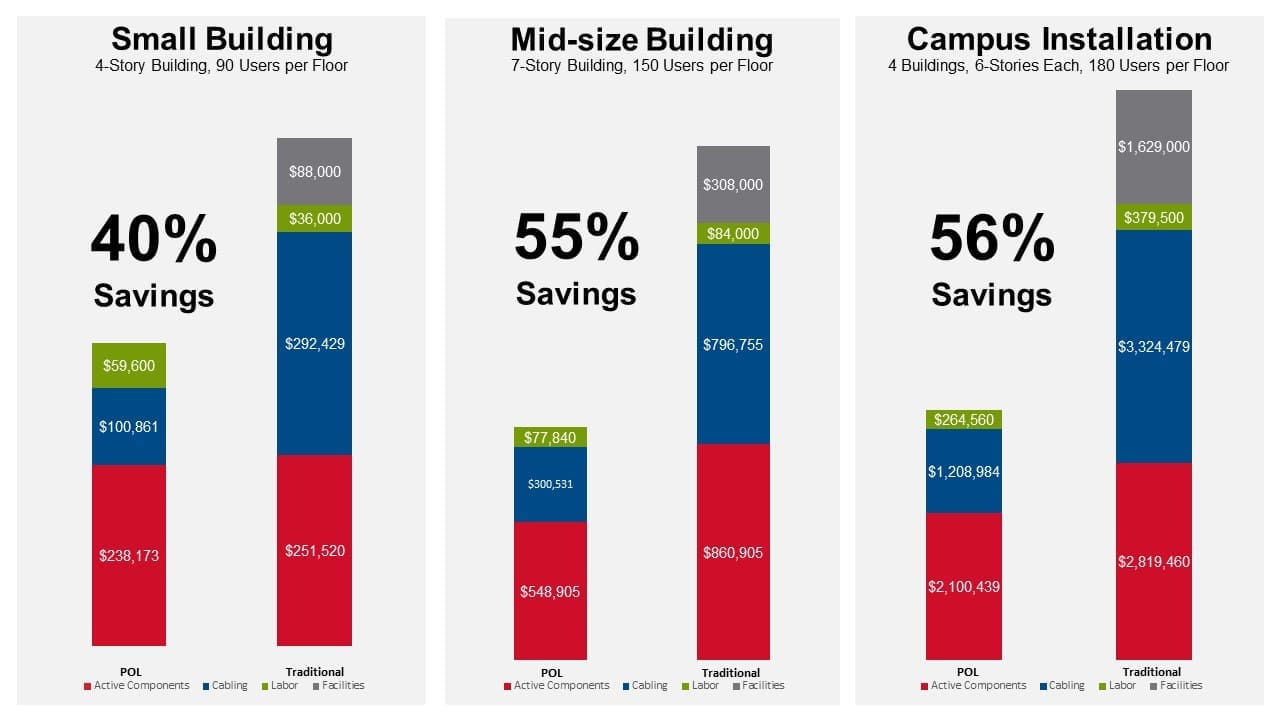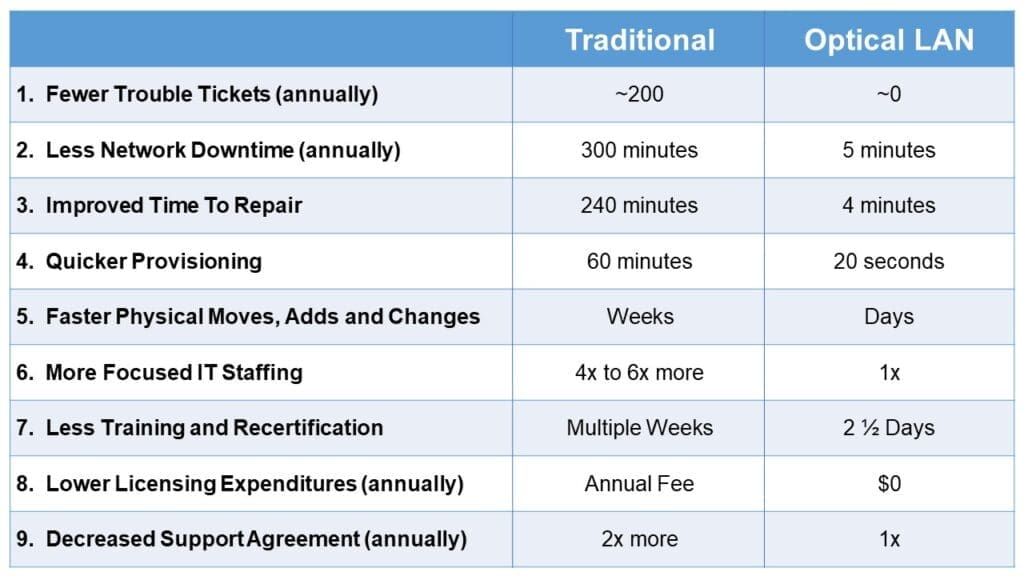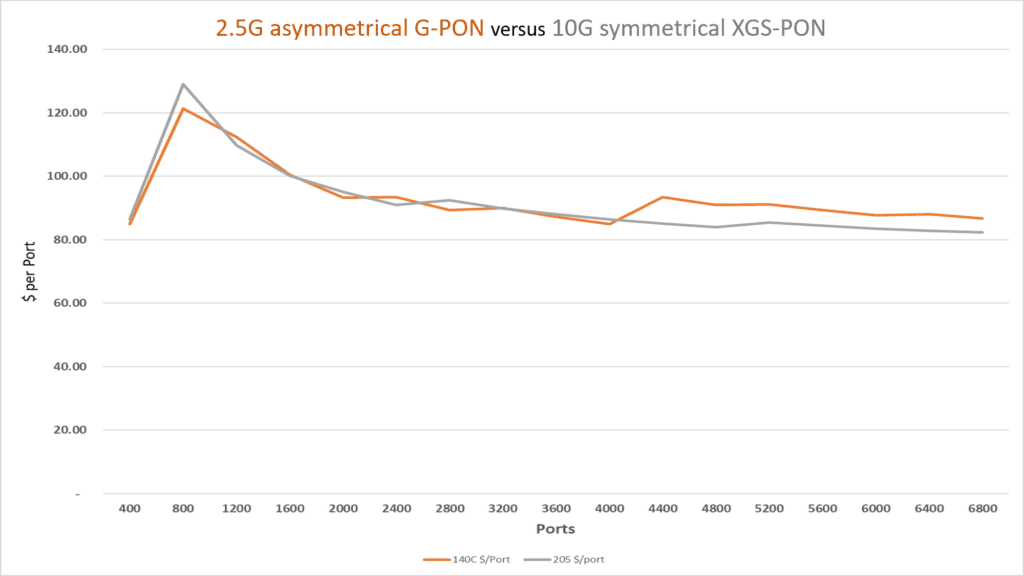Passive Optical LAN is the smart investment that saves money at installation and over its extended operational life.
The useful life expectancy of traditional enterprise LAN infrastructure is regrettably short. At each one of these technology upgrades, the switch and cable manufacturers expected you to rip-and-replace your hardware and infrastructure. Each higher bandwidth step and faster network speed introduces significant business disruption and costs. Furthermore, during this same time period traditional switch venders are complicating matters by raising network complexity, day-1 capital cost and year-over-year operational expenses at each step of the way.
Passive Optical LAN (POL) is a better way to build and operate networks. POL architecture speeds IT productivity through simplification. It reduces network vulnerability points. It offers flexible design options to economically right-size network capacity and density. POL is a smart investment for modern fiber-based connectivity inside buildings and across extended campus.
The purpose of this white paper is to detail how POL saves day-1 capital expenditures (CapEx), year-over-year operational expenditures (OpEx) and has cost parity between G-PON versus 10G PON. Through-out the paper we will share multiple studies that support and confirm how POL delivers:
- Up to 60% savings in day-1 capital costs compared to traditional LAN design
- Nine times the savings in year-over-year operational costs compared to legacy networks
- Investment protection with graceful migration from 1G to 10G, 10G to 40G and beyond
- Energy consumption reductions and the rippling effect for building power and cooling savings
Up to 60% savings in day-1 capital costs
Over the years we have heard our customers report day-1 CapEx savings by choosing POL over a legacy network design. Customers can range is size from a single small Santa Fe Public School campus saving $60,000, to national manufacturer SK Food Group saving $100,000 at one facility, and to a large USMC MCRD San Diego campus saving $1,800,000.
In a recent internal cost analysis, Tellabs examined two (2) equipment-to-equipment cost comparison scenarios covering architectures for [Figure 1]:
- Closet-based POL
- Deep fiber POL

Figure 1.
Closet-based POL – Closet-based POL best replicates traditional LAN architectures as high-density Optical Network Terminals (ONT) directly replace workgroup switches inside the telecom closets (IDF) and the last 300’ CATx cabling is leveraged. The benefit of this architecture is that it provides a migration path to deeper fiber architectures, you reuse existing horizontal copper cable drops and you immediately take advantage of POL’s centralized software defined management. The cost comparison study that follows is based on an Optical Line Terminal (OLT) positioned in the main data center, also known as the Main Distribution Frame (MDF). This OLT is capable of serving both G-PON and 10G XGS-PON. For this configuration it is equipped with 10G XGS-PON that connects a one rack unit (1RU) 48-port 10/100/1000 Ethernet Optical Network Terminal (ONT) rack mounted in a telecommunications room, also known as Intermediate Distribution Frame (IDF). This design is then compared to a one-to-one Cisco 9200 and Cisco 9300 configurations replacement.
Deep Fiber POL – Deep Fiber POL removes the switching equipment from the telecom closets (IDF) by positioning the ONTs as close to the end-device and end-user connectivity as possible. The benefit of this architecture is that you can fully realize all the great benefits of single mode fiber cabling, it has a better day-1 capital expense savings percentage and best year-over-year operational savings. In the cost comparison referenced, we represented G-PON/10G-PON OLT located in the main data center and 10G-PON deep fiber ONTs equipped with both 10/100/1000 Ethernet and multi-rate 1G/2.5G/5G/10G Ethernet. Again, this scenario is then compared with Cisco 9200 and Cisco 9300 configurations.
The outcome of this analysis showcases steady savings for all POL projects ranging in size from 192 PoE enabled Ethernet ports to over 7,000 PoE enabled Ethernet ports. These calculations illustrate how up to 60% savings on initial purchase versus legacy switch vendor is possible with POL [Figure 2].

Figure 2.
Furthermore, the Association for Passive Optical LAN (APOLAN) Technology Committee recently published the results of a cost comparison between POL and legacy switch too. Their modeling details savings from 40-56% for POL based on three differently sized deployment scenarios and validates the CapEx saving potential of POL [Figure 3].

Figure 3.
The APOLAN Technology Committee study analyzed the cost of POL parameters (e.g. 4-port PoE ONTs, ONTs shared in cubicles, 2:32 splitters, zone box solution and no telecom rooms) versus those of traditional parameters (e.g. 48-port PoE switches, One 10G uplink per telecom room stacked switches and 2 CAT6 drops per user). The comparison was then built out to represent one 4-story building with 90 users per floor, one 7-story building with 150 users per floor, and four 6-story campus buildings with 180 users per floor.
Nine times the savings in year-over-year operational costs
POL architecture has proven to be more flexible in design, and lower in cost, all while balancing the escalating complexities of the modern network. Yet, often the tangible benefits associated with operational efficiencies get overlooked.
These year-over-year savings can pay annuities in the thousands and can quickly add up to millions of dollars for our customer. Our customers tell us that theses quantifiable benefits can be achieved as a result of POL’s superior performance in the following nine areas [Figure 4].
- Fewer Trouble Tickets (annually)
- Less Network Downtime (annually)
- Improved Time To Repair
- Quicker Provisioning
- Faster Physical Moves, Adds and Changes
- More Focused IT Staffing
- Less Training and Recertification
- Lower Licensing Expenditures
- Decreased Support Agreement Costs

Figure 4.
Now, let’s expand on these nine operational efficiency benefits by providing more details to each.
Fewer Trouble Tickets – Our customers have reported reduced trouble tickets resulting from unplanned network outages. In fact, several customers have reported zero trouble tickets spanning years of active service. The numbers showcased in this matrix, truly come from a large US government intelligence agency customer. This reduction is attributed to how a POL system can be operated with less human touch which directly improves network reliability.
Less Network Downtime – Based on calculated average Mean Time Between Failure (MTBF), a traditional network design can expect 5 hours of network down time (99.9% uptime) and a POL can expect 5 minutes of down time (99.999% uptime). The cost to build a more resilient traditional network design with redundant switches, cards and ports configured in a more reliable meshed architecture is exorbitantly higher compared to POL.
Improved Time to Repair – POL is inherently easier to isolate trouble because of its passive architecture. That is, there are no moving parts between the OLT out to the ONTs, and the POL equipment management software see all ports inside buildings and across extended campus as one big virtual switch. The matrix calculations are based on the replacing a rack-mounted 48-port workgroup switch, plus performing Security Technical Implementation Guide (STIG) on that replaced switch, versus the simple plug-and-play process of replacing an ONT.
Quicker Provisioning – Fundamentally POL is quicker to provision because of its underlying centralized intelligence and software defined management. Within a PON Element Management Software (EMS), the global profiles provisioning can be completed in 1-click or even zero touch. The bigger benefit of reduced provisioning is ensuring consistent procedures are implement without human error. Reduced human touch directly improves network reliability, security and operational efficiencies.
Faster Moves Adds and Changes – Modern networks need to be simple, flexible and scalable to support economical Moves, Adds and Changes (MACs). This can be exacerbated by large buildings and sprawling properties. With a traditional network architecture, adding connectivity ports may require moving or adding a cabinet, adding a new switch and/or running copper cabling all the way back to the main data room (MDF), telecom closet (IDF) or cabinet. This process is extremely time consuming, complex and expensive.
More Focused IT Staff – When discussing IT staff reductions, it is important to put this in context of addressing skillset gaps and talent shortage. The main objective of reducing the time and staff needed to operate a network, is that it unleashes your top-talent to focus on more critical tasks, like security or Wi-Fi performance. In the government sector, we commonly hear our customers experiencing a 4:1 to 6:1 repurposing of IT staff. In a recent case study, SK Food Group articulated how they were able to do the majority of their MACs with an IT Technicians (~$45 an hour) without needing to hire a more expensive Network Engineer (~$90-$130 an hour).
Less Training and Recertification – It’s well documented how traditional network manufacturers require multiple weeklong training every 2 to 3 years to maintain CCNA, CCNP or CCIE credentials. Even a prominent switch vendor CEO admitted that his company makes $15 in operational costs for every $1 in equipment cost. POL operational, provisioning and maintenance (OPM) training class can be completed in 2 ½ days for significantly less cost.
Lower Licensing Expenditures – Major switch venders are complicating operations by constantly elevating network complexity with a hierarchy of software licensing expectations. They’ve also been steadily raising day-1 cost and year-over-year operational expenses of those licenses. Typically, POL software is owned in perpetuity and does not require annual renewal.
Decreased Support Agreement Cost – POL can lower annual support costs compared to what traditional switch manufacturers charge. These types of year-over-year operational expense savings for SK Food Group are significant. For example, this POL customer cut their annual support costs in half as they transitioned from a major switch vendor 24x7x365 annual support to POL 24x7x365 annual support (including advanced equipment replacement).
Investment protection with graceful migration from 1G to 10G, 10G to 40G and beyond
POL provides investment protection with a future-proof design that delivers industry leading flexibility with the best possible capacity and density. In particular, POL systems can be equipped with either symmetrical 10G XGS-PON (ITU-T G.9807.1) and 2.5G G-PON (ITU-T G.984), and it stands ready to support NG-PON (ITU-T G.989) in the future.
As we have already heard, POL customers often speak of good capital expense savings and fantastic operational savings, while improving network uptime, removing network points of vulnerability and future-proofing their network. Better yet, there is cost parity with asymmetrical 2.5 gigabit G-PON and symmetrical 10 gigabit XGS-PON, plus POL flexible design options offer additional smart money savings.
Today, POL customers can choose between symmetrical 10G XGS-PON and 2.5G G-PON. Better yet, this can be done with no premium in capital expenditures. Thus, the enterprise network installations that leverage POL equipment have greatest confidence in ensuring the highest degree of network performance and investment protection moving forward.
In this next cost study, we compared the relative expense of deploying G-PON OLT with deep fiber G-PON ONTs and 10G XGS-PON OLT with deep fiber 10G XGS-PON ONTs. The main difference is one cost model featured G-PON XFP pluggable optics with a 1:32 optical split (and deep fiber 4-port G-PON ONTs) and the other utilized symmetrical 10G XGS-PON XFP pluggable optic with a 1:64 optical split (and deep fiber 5-port 10G XGS-PON ONTs). The outcome of this study proves cost parity between G-PON and XGS-PON and confirms future investment protection for customers seeking a lower price solution today [Figure 5].

Figure 5.
Keep in mind that there is no known bandwidth limitation for fiber cabling, so POL customers can freely migrate to next-generation technologies gracefully and economically in the future too. This is possible because POL is based on wave-division multiplexing technology enabling today’s infrastructure can support of 2.5G G-PON and 10G XGS-PON with no wavelength conflicts. In the future, POL customers can upgrade their network on a per port basis to 10G, 40G and 100G PON speeds, then economically place 10G, 40G and 100G next-gen PON ONTs only where that increased capacity is truly required.
Energy consumption reductions and the rippling effect for building power and cooling savings
Customer-generated business cases have shown that Optical LAN can reduce energy consumption by up to 20-50% using OLT and ONTs instead of a traditional copper-based active Ethernet LAN [Figure 3]. With a fully meshed hierarchy of active Ethernet switches, energy is consumed every time an optical-to-electrical conversion or electrical-to-optical conversion occurs. With fewer O-to-E and E-to-O conversions, a network based on PON architecture will consume less energy.

Figure 6: Energy use analysis of traditional LAN (188 48-port switches serving 9,000 endpoints) versus Optical LAN (2,250 4-port ONTs serving 9,000 connections) that shows 60% in savings for OLAN. You can read our blog “Optical LAN Energy Usage Comparison Unveils Rippling Effect for Building Power and Cooling Savings” that explains this Optical LAN energy usage comparison in more details.
When the energy savings of Optical LAN is reviewed, it is easy to see the rippling effect of the savings relative to the electrical (plug load) and thermal (HVAC) load design of the total building. For example, one (1) watt of electricity consumption saved in a data center results in 2x savings throughout the entire building. This is a direct result of needing less DC/DC, AC/DC power distribution, and transformer, generator and battery backup. From a thermal standpoint, the Optical LAN’s lower energy consumption requires less HVAC capacity. Forward-looking building design could even use extended temperature range OLTs in data centers/telecom closets and use only fresh air ventilation, eliminating any need for forced air conditioning. Better yet, locate the OLT beyond the building footprint, and couple with solar powering, and provide a true net-zero network.
Adding up all the possible energy and thermal saving for Optical LAN, the gains can be contributed to:
Network Power Lowered – The energy use analysis presented above compares a traditional LAN built with 188 48-port switches that serves 9,000 endpoints to an Optical LAN with 2,250 4-port ONTs serving 9,000 connections [Figure 3]. This comparison shows 60% in savings for PON. This is consistent with real-world Optical LAN deployments, like Department of Energy Sandia National Laboratory, that have experienced savings as much as 65% in power consumption as a result of OLAN (e.g. 1 million kwh saved per year at Sandia).
Reduced Air Conditioning – Another reduction in energy can be gained by lower air conditioning. This is possible because of reduced or eliminated telecom rooms, and because the ONTs and OLTs can operate at extended temperature ranges. The energy comparison provided in Figure 3 calculates a 60% dollars savings in cooling impact alone for PON and 60% savings in kilowatts per hour [Figure 3].
More Efficient Power over Ethernet (PoE) – Finally, we have been seeing that Power over Ethernet (PoE) can be delivered more efficiently over an Optical LAN architecture – as much as 13% power saving with PoE over OLAN! This is simple physics, as the closer you can position the powered devices (i.e. VoIP phone, IP camera, Wi-Fi access point) to the PoE source (i.e. ONT), the shorter the distance the PoE needs to travel, and the lower the power loss through inefficiencies will be.
Flexible design options that economically right-size network capacity and density
Please note that these cost studies are approximate estimates only and not quotes nor guarantees. The costs represented in these studies will vary based on numerous factors including, but not limited to, geographic region, local market, labor, manufacturer and distribution impacts.
Passive Optical LAN offers flexible design options with the best capacity, density and performance. It scales bandwidth capacity, and number of connected devices, with true network needs. POL can connect any network design, cable, service and endpoint. It breaks traditional network barriers for connecting modern smart buildings and Internet of Things (IoT) devices. POL is a wise investment with the least disruptive path to future technologies that saves significant CapEx and OpEx compared to legacy networks as seen in the studies outlined in this white paper.
